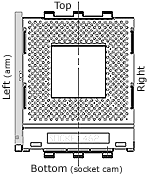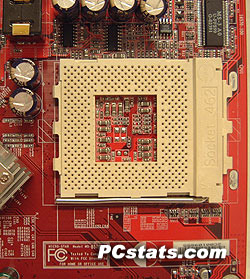The AMD AthlonXP is a hot processor,
proper cooling is essential to the longevity of the CPU. Larger heatsinks
generally offer better cooling so the question as to
what the largest size a motherboard will accept pops up.
Since AMD doesn't currently use any
standardized heatsink retention mechanism there is a lot more freedom in terms
of the overall size an Athlon heatsink can take. Throw in the mixed layouts of
many different mainboards and you have a problem on your hand. Not all AMD
heatsinks will fit cleanly on all AMD motherboards, especially if the heatsink
is large, or requires the use of now obsolete mounting holes.
| pcstats heatsink clearance measurements |
| top clearance: |
7 mm |
| bottom (cam) clearance:
|
11 mm |
|
| left side (arm) clearance:
|
31 mm |
| right side clearance |
15 mm |
|
| socket mounting holes:
|
none |
| max. heatsink base dimensions:
|
~80x85 mm |
|
 Note: Approx.
measurements are made from the edge of the socket (not the clips) to
the closest obstacle taller than the ZIF socket
itself.The socket is 51mm across, and 62mm from
top to bottom. Note: Approx.
measurements are made from the edge of the socket (not the clips) to
the closest obstacle taller than the ZIF socket
itself.The socket is 51mm across, and 62mm from
top to bottom.
| |
 |
MSI did a fair job in clearing the CPU socket area of any extremities and you shouldn't have many
problems fitting larger heatsinks like the Thermalright SLK-800. The board lacks any heatsink
mounting holes around the socket area because they're no longer required
by AMD. If it's possible, I'm sure the enthusiast community would
love to see those holes back on their motherboards - but I say
just use a heatsink with a three prong clip and you'll be
fine.
What everybody wants, overclocking...
It would be nice if MSI would release a BIOS
that unlocks the processor by default because we could not manipulate the multiplier in this case. Overclocking was
done via FSB adjustments which can be cumbersome. In any case we began to raise the FSB slowly
and started to see stability problems around the 173 MHz FSB
mark.
A quick increase of the CPU voltage to 1.75V solved the problem. At 175 MHz
FSB we hit another wall, and no matter what I tried, nor what CPU VCore was used, the
AthlonXP 2700+ just wouldn't budge above 175 MHz FSB. A bit disappointing, but those are the breaks,
and since we tested with the integrated video that may have been a
factor.
